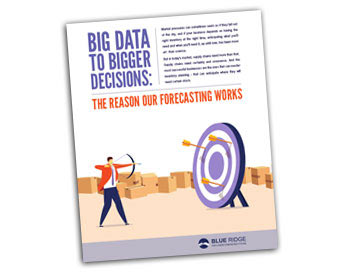Big Data to Bigger Decisions : The Reason Our Forecasting Works
Market pressures can sometimes seem as if they fall out of the sky, and if your business depends on having the right inventory at the right time, anticipating what you’ll need and when you’ll need it, up until now, has been more art than science.
But in today’s market, supply chains need more than that. Supply chains need certainty and assurance. And the most successful businesses are the ones that can master inventory planning -- that can anticipate where they will need certain stock.
The reason employing a team of planners and some outdated software built on 20-year-old technology that uses basic algorithms and historical averages just doesn’t cut it anymore is because marketplaces today just move too quickly. In a digital economy variables change too rapidly for businesses to keep up with – let alone get in front of. Trend changes, policy changes, monetary changes, even weather changes all have an impact on business and all happen faster than any one person or even a team of people can analyze and process.
Throw in sourcing or scarcity issues on top of all that and all of these factors accumulated means that your team of planners has to operate beyond their capacity. Inventory planning becomes the ultimate problem for supply chains to solve if they want to maximize profits. Are businesses really doing everything they can to make sure the right products are at the right place at the right time? Are they covering demand as optimally as possible – balancing those carrying and acquisition costs? Smart forecasting is no small chore for a team of buyers and planners using traditional, on-premises software. Smart forecasting – smart inventory planning is the edge today’s businesses need -- knowing exactly where to send inventory. Not too much. Not too little. But just enough to meet true demand while minimizing costs to the business – Is your supply chain able to reach that Goldilocks zone?
That’s why we developed Blue Ridge
Businesses spend a lot of time and resources looking for this zone. They have planners poring over data trying to determine where the next score is, but what if they didn’t have to because they were able to see the score coming? What if they were able to get goods to their prime destinations at the exact moment of demand? What if supply chains really had a scalable system that could automate the data analysis – that could meet the exponentially growing scale of the marketplace with technology that could scale to meet it?
Think of it like this: A medium sized supply chain with five inventory planners sitting in a room twenty-four hours a day forecasting demand based on their calculations of past demand data is not good enough for determining that Goldilocks zone. And neither is 10 buyers. Neither is 50!
There are a couple of reasons why not
The first reason is obvious. It’s complexity. There are simply too many variables to consider. Those planners have to figure out how to meet demand, balance risk, avoid stock outs, figure in supplier constraints and carrying costs, and maybe even future stock conditions. Throw in an unplanned disruption or two.
Nobody can solve this complexity on their own – and throwing bodies at it only serves to make the planning process even more inefficient. More warm bodies aren’t going to solve the problem and adding bodies only leads to the second reason why the answer to the problem isn’t people.
Cost
No business has the capital to hire the number of people it would take to meet an exponentially complex and growing marketplace. It just can’t be done profitably without software. Not at the scale the market demands.
Meeting the challenge of inventory planning and forecasting in a digital economy revolves around the ability to process and manage continuous data uptake. Put as simply as possible, inventory planning and demand forecasting is a big data problem. The solution today and in the future is all about processing speed and power and the ability to see patterns as they appear.
A team of inventory planners would always be overworked and understaffed. When markets and trends shift, these teams would quickly fall behind without action-ready recommendations from their supply chain planning solution.
So, what does optimal planning and forecasting need to work in the digital marketplace?
Processors and machine learning, for starters. It’s big data to big decisions
Imagine if your inventory planner could calculate the stock levels needed for each and every inventory item – and those levels exactly met service and product goals. Imagine if your planner could build order forecasts that fulfilled forecast demands like a hand in glove. Never too much stock. Never too little. Always just right.
Imagine if your planners could adjust for special considerations. If it could reconcile constraints and revise and reoptimize after factoring in every sort of variable that a business could throw at it.
That is a powerful edge
Now imagine if it could do that for your business everyday! Imagine if it could do it multiple times a day!
That is exactly the problem we solve at Blue Ridge. We do the heavy lifting and provide the action-ready recommendations that help buyers and planners optimize their day. Our industry leading forecasting and optimization software keeps an eye on your moving targets and updates accordingly. We help planning, forecasting, and replenishment teams stay in the Goldilocks zone by automating the forecasting processes with the power of machine learning and the cloud.
Very simply, we help supply chains process both historical and incoming data faster – in real-time.
Our enterprise-ready, forecasting automation platform increases performance and productivity by moving complexity to an engine and managing processes via one easy to use interface – down to individual SKUs.
If survival is the game, then inventory planning is the edge
We do it over and over every day in a range of businesses that need to optimize inventory planning. Take a look.
See why we lead the pack. See the proof points and our data sheets, and then see why our customers call us the best value in the forecasting automation business.

TODD CRAIG
CHIEF MARKETING OFFICER



Comments are closed.